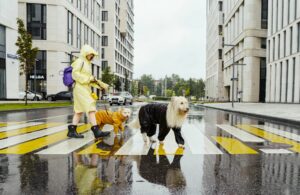
Moving to a new neighborhood is an exciting adventure, but it can also be a stressful experience, especially for your furry companions. Dogs thrive on routine and familiarity, so a sudden change in environment can lead to anxiety, confusion, and behavioral changes. As a responsible pet owner, proactively help your dog adjust to new surroundings, ensuring they feel safe, secure, and comfortable.
In this guide, we’ll explore practical strategies to help your dog feel at home in their new environment.
1. Establish a Familiar Routine
Dogs thrive on consistency, and maintaining a structured routine can significantly ease their transition into a new neighborhood. A study published by the NIH found that dogs with consistent routines generally exhibit lower cortisol levels, a key indicator of stress. Maintaining a regular schedule provides stability and helps reduce anxiety in dogs compared to those with irregular routines.
Hence, maintain your dog’s regular daily rhythm for meals, walks, play, and sleep. Consistent routines offer a feeling of security and lessen the stress and anxiety that come with moving. Walk your dog at their usual times, using familiar words and signals to help them feel more at ease.
Set up your dog’s bed, food bowls, and toys as they were in your previous home. Continuing consistent daily interactions and training routines will further boost their sense of security. A predictable routine helps your dog adapt to their new environment more quickly and with much less stress.
2. Explore the Neighborhood Together
The Conversation reported that dogs move differently when off-leash, using space more freely and exploring at a wider range. They tend to run faster and cover more ground compared to when they are on a leash. This off-leash activity provides essential exercise, keeping them both physically fit and mentally stimulated.
However, in newer neighborhoods, begin with short, leashed walks, letting them explore and sniff at their own speed. Show them the local parks, streets, and popular walking paths, all while remaining calm and reassuring.
Introduce your dog to neighbors and their dogs gradually and positively to ease their anxiety and help them feel at home. Initially, stick to familiar walking routes to build confidence and security before venturing further afield. Don’t rush the process; a slow, steady approach to exploring their new environment is crucial for a successful transition.
3. Introduce Your Dogs to Neighbors and Other Pets
Socialization is key to a smooth transition. Introduce your dog to your new neighbors and their pets gradually and safely. Keep initial encounters brief and supervised, preferably on the leash and in neutral territory. Avoid forcing interactions; let your dog approach at their own pace. Positive reinforcement, like treats and praise, can help create positive associations with new people and animals.
If your dog seems anxious or overwhelmed, separate them and try again later. Respect their boundaries and allow them to adjust at their own speed.
4. Manage Pet Waste Responsibly
Responsible pet ownership includes proper waste disposal. Not only is it courteous to your new neighbors, but it’s also crucial for the health of your dog and the environment. Leaving pet waste unattended can spread parasites and bacteria, impacting both animal and human health. Plus, it’s just unpleasant for everyone.
Scoop Soldiers notes that pet waste can make using your yard difficult, forcing you to constantly watch where you step. Accidentally stepping in the wrong spot can feel like dodging landmines, ruining outdoor activities. Worse yet, slipping on waste can quickly turn quality time into an unpleasant experience. So, make it a priority to clean up after your dog every time, everywhere.
In addition, many cities prioritize responsible pet ownership, emphasizing proper waste management to keep the environment clean and healthy. For example, in Colorado Springs, local regulations require pet owners to regularly remove fecal waste from their premises to prevent odors and contamination.
The Municipality of Colorado Springs reported that city codes require pet waste to be disposed of in flytight containers at least every seven days. Households with multiple or larger pets may be required to remove waste more frequently to comply with local regulations. The Code Enforcement Officer has the authority to enforce stricter waste removal schedules if necessary to prevent nuisances.
By adhering to these guidelines, pet owners contribute to a cleaner community while ensuring the well-being of their pets and neighbors.
For homeowners, maintaining a clean yard is equally important, especially in a city that values its outdoor spaces and community pride. If you’re short on time or need a reliable solution, consider hiring a professional pooper scooper Colorado Springs service. These services provide regular cleanups, ensuring your yard remains pristine and your neighborhood stays beautiful.
Are professional pet waste removal services worth it?
Professional pet waste removal services are a great option for busy pet owners seeking a clean, odor-free yard without the hassle. These services ensure proper waste disposal, minimize bacteria exposure, and save valuable time. They are especially beneficial for multi-dog households and individuals with mobility challenges, promoting a healthier environment.
5. Secure Your Home and Yard for Safety
Before your dog explores their new home, thoroughly assess and secure your property. Check for potential hazards, such as exposed wiring, toxic plants, or gaps in fencing. Ensure your yard is securely fenced to prevent escapes, especially if your dog is prone to roaming.
The Animal Humane Society reports that an estimated one in three pets will go missing during their lifetime. This equates to roughly 10 million missing pets annually in the United States, with many escapes occurring from unsecured yards. The data emphasizes providing a designated safe space indoors to help reduce anxiety and offer comfort and safety.
How do I prevent my dog from escaping in an unfamiliar environment?
To prevent your dog from escaping in an unfamiliar environment, secure fences and gates, use a leash on walks and supervise outdoor time. Ensure they wear an ID tag and consider a GPS tracker. Establish a routine, provide mental stimulation, and create a comfortable indoor space to reduce escape-driven anxiety.
6. Find a Local Veterinarian and Pet Services
A local vet ensures your pet receives timely medical care, vaccinations, and wellness checkups. Research clinics nearby, read reviews and schedule an introductory visit to familiarize your dog with the new vet. Additionally, identify pet services such as groomers, pet supply stores, boarding facilities, and dog walkers.
Knowing where to find emergency pet care is also crucial in case of unexpected health concerns.
What criteria are important when picking a vet?
When choosing a new vet, consider their experience, services offered, location, emergency care availability, and client reviews. Ensure they have a good rapport with your pet and use modern treatment methods. Check their office hours, fees, and approach to preventive care to ensure they meet your pet’s specific needs.
Helping Your Dog Adjust Comfortably
Moving to a new neighborhood is a big change for your dog, but with patience and care, they can quickly feel comfortable. By taking proactive steps, you ease your dog’s anxiety and help strengthen their sense of security in their new environment. Every dog adjusts at their own pace, so provide plenty of reassurance, consistency, and love.






